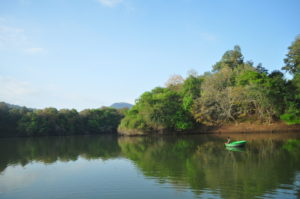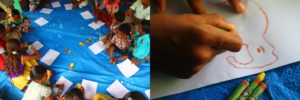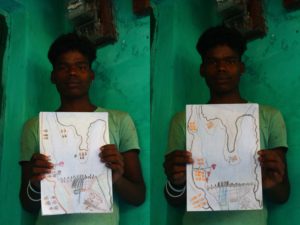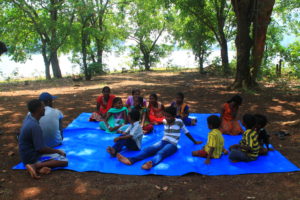The Irula tribes have always been an integral part of the forests of the Nilgiri Biosphere Reserve, but the recent ‘development’ and changes in lifestyle are affecting the way they interact with the forest.
Several hamlets, each of approximately 9-10 families, dot the roads within the reserve forest. These houses are similar to the village homes that are found all over the country, and not like the traditional tribal huts they originally built. Nowadays, they even rear cattle, goats and poultry, while some have plantations of banana or silk cotton. They also depend on fishing in the Bhavani river as another source of their livelihood. Some of the Irula kids do not necessarily follow their elders to learn the ways of the forest, but leave their homes and spend the academic year in travelling near and far where they receive modern education. It is during the summer vacation months or weekends that they return home.
The majestic Bhavani river along with the forests and mountains form the perfect backdrop to interact with these children and their immediate environment. Already endowed with traditional knowledge of plants and remedies,birds and their behaviour, fishing practices, the program focused on emphasising on ecological concepts through games and educational activities.
13th May 2016
The first day’s activities began in the resource centre of Keystone in Kilsengalur Grama Vana Kulu in the Pillur Village which lies behind the Pillur Dam. Around 13 children, ranging from ages five to seventeen participated from the nearby hamlets.
Visualising change
Each participant was given two sheets of paper and some crayons, and the task consisted of two parts. On the first sheet, they had to draw their homes and/or its surrounding environment as they saw it now. Some drew animals, birds and butterflies that they frequently saw in the forests, while some sketched the village with a few houses, cattle and their neighbours.
The next part was to visualise what their village would look like after 20 years.
The participants’ drawings drastically changed. When they were asked to explain the two drawings, they were able to identify the changes happening all around them. They recognised that the water level was reducing, that the forests were being cut to expand plantations, and that more and more houses were being built to sustain the growing population.
After lunch, the children were taken outdoors to play several games at a nearby ground.
Prey & Predator
In this game, the children played the roles of different animals to understand feeding stress, and the food chain within the ecosystem. The children were divided into two groups, ‘Frogs’ & ‘Snakes’. Some stones and stone fruit were kept in the middle of the ground which were ‘Food’ for the frogs. The aim of the Frogs was to hop to the feeding ground and ‘eat’ or pick up 3 stones, and make it back to safety, while avoiding the snakes. The Snakes were allowed to run, to capture the feeding frogs. This game put into practice the food chain and food webs that they learnt at school.
Distance & Direction
This game is designed to highlight the importance of distance and direction while navigating through the forest. Four children acted as the four corners of the field and the aim was to touch each of these corners to complete the game. Only one participant was allowed at a time and he or she was blindfolded. The blindfolded participant relied on his friends to guide him or her through the ground with verbal cues and directions. While some participants were able to traverse the field with ease, others found it quite challenging. In the forest, it is a life saving skill to be able to navigate distances with the help of sound and a sense of direction.
14th May 2016
The setting for the next day’s program was a hamlet of about 15 houses in Niradi. Local kids were about 8 and 10 children from several other hamlets like Kilpillur and Sithugunai assembled in a volleyball field along the banks of the Bhavani reservoir.
Dog & the Bone
This classic game was slightly modified to teach the kids about different animals and their food habits. The two teams of 5 each had to assign themselves with 5 different animals ‘Tiger, Gaur, Bear, Monkey and Leopard’. When their respective animal was called out the animal from both the teams had to seize the ‘prey/food’ wood stick in the middle of the field. Then they had to discuss the different diets that each of these animals have.
Storytelling & Interaction
Chandran R and Rajender R, local personnel from the Keystone foundation discussed with the children the different medicinal applications of certain plants and tree. For example, the girls from the group remarked that boiled leaves of the guava tree help in healing tooth aches. Later, they taught other current concepts such as how energy is derived from water, and about the distribution of 100MW of electricity generated from the Pillur dam. Giving an account of the history of the dam, he told the kids that the water levels used to be much higher than there are today. Moreover, the Britishers used to hunt crocodiles for their leather, and now no crocodiles are found after the construction of the dam. A fish called Sisi, in the local vernacular, used to be caught in huge numbers some 60 years ago; and each fish alone weighed 50 kg! Today, they are not easily found in the river waters. The children listened raptly and expressed how valuable their forest and river was. They seemed to understand that the natural resources they enjoy are more valuable than any other luxury that they can buy. To conclude the talks, Chandran R narrated a hilarious story about the adventure of 4 fools.
The children were then treated to a delicious meal of rice and fish. After the program they all ran off into the river to swim and play with their friends!
The two days were a great opportunity for the children to learn various important things and play games that taught them about the ecosystem. Most importantly, the greatest take home message was the fragility and the interactions in the environment that they lived in.
Text credit: Anushka Kale






